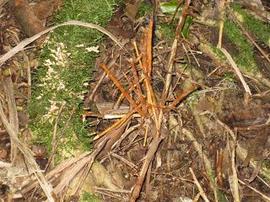More about.....
Mangroves
The key feature of plants adapted to the mangrove habitat is their ability to deal with brakish or saline water. Our own mangrove plant, Avecennia marina, is one of the best adapted to deal with salt water. Avicennia is also viviparous, the seeds starting to germinate on the parent tree before the newly formed root is shot into the mud like an arrow when the parent lets the offspring go.
Other features of mangrove species are the presence of prop roots to steady the plant in shifting tides and pneumatophores to allow oxygen to reach the roots.
Mangroves bestow many advantages on their environment: slowing erosion (think of the economic
benefits there!), providing a relatively disturbance-free environment for micro-organisms and small (or large!)
crustaceans to thrive and even giving shelter to large animals hunted by man, in tropical mangroves (eg.
tiger, shark).
Thanks to many contributions from members of the group and Nancy's beautiful slides from many parts
of the world, we all know a little more about mangroves.
Other features of mangrove species are the presence of prop roots to steady the plant in shifting tides and pneumatophores to allow oxygen to reach the roots.
Mangroves bestow many advantages on their environment: slowing erosion (think of the economic
benefits there!), providing a relatively disturbance-free environment for micro-organisms and small (or large!)
crustaceans to thrive and even giving shelter to large animals hunted by man, in tropical mangroves (eg.
tiger, shark).
Thanks to many contributions from members of the group and Nancy's beautiful slides from many parts
of the world, we all know a little more about mangroves.
